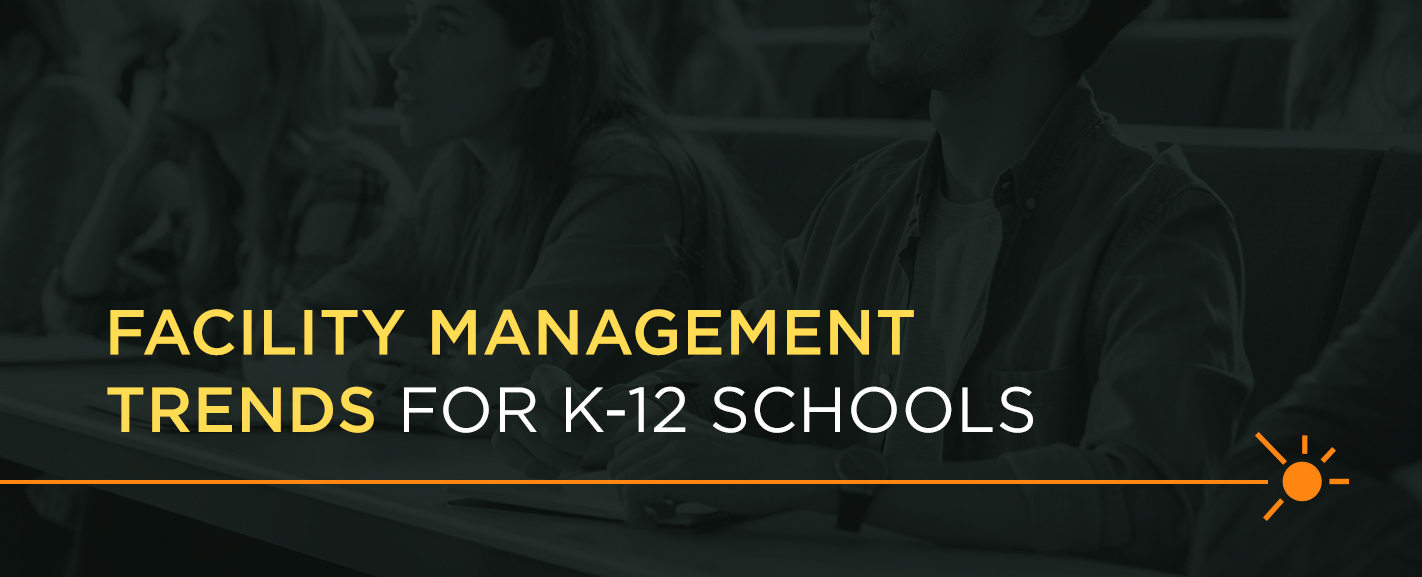
According to the National Center for Education Statistics, there were 132,853 K-12 schools in the U.S. as of the 2015-16 school year. These elementary, middle, and high schools saw about 56.6 million students attend in Fall 2019. With millions of students attending K-12 schools across the country, these schools must support student learning and stay up-to date with the latest trends. As these trends continue to evolve, K-12 schools must evaluate their school’s design, keep up with the way the classroom is changing due to advancements in technology and make necessary changes to create a sustainable K-12 facility. By staying updated, you can help ensure your students are receiving a quality education in an optimal school environment. Let’s take a look at the top education sector trends affecting facility management in K-12 schools.
K-12 Facility Design Trends
In today’s K-12 schools across the U.S., the classroom experience is changing. Students are no longer seated in desks all day while the teacher stands at the front of the room and lectures. To reflect this new and ever-evolving way of learning, many schools are changing their facility design to keep up with the trends. With advancements in technology, new teaching and learning styles and things like sustainable design, designers are looking at school facilities differently than before to incorporate these elements for a successful school that meets everyone’s needs. Designs reflect the shift from the formal learning experiences of the past and focus on safety, security and students’ needs.
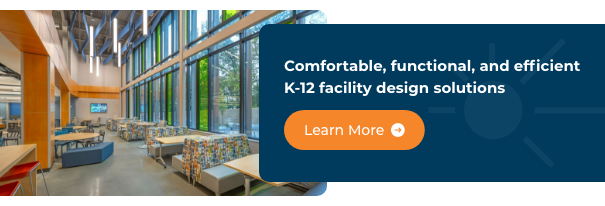
Design to Reflect Safety and Security
It’s crucial that students in K-12 schools across the U.S. are as safe as possible while at school and can get their education without constantly fearing for their safety. Today’s facility designs should reflect this concern and can help with security. Today, most school designs include a security vestibule positioned outside the school building’s front door and the school day starts after all of the students are inside. Then, the vestibule and other doors to the school are locked. A school staff member stays inside the central vestibule, controlling who gains entry to the school.
Design to Reflect Students’ Evolving Needs
Schools should have a student-centered design that can accommodate the way students learn best. Designs can support critical thinking skills, problem-solving, and active learning through things like outdoor classrooms and flexible learning spaces. One study found that 73 percent of all student progress that could be traced back to classroom design was linked to flexibility and student ownership. Flexible learning spaces should include things like varied seating options for students, movable partitions and various learning areas such as:
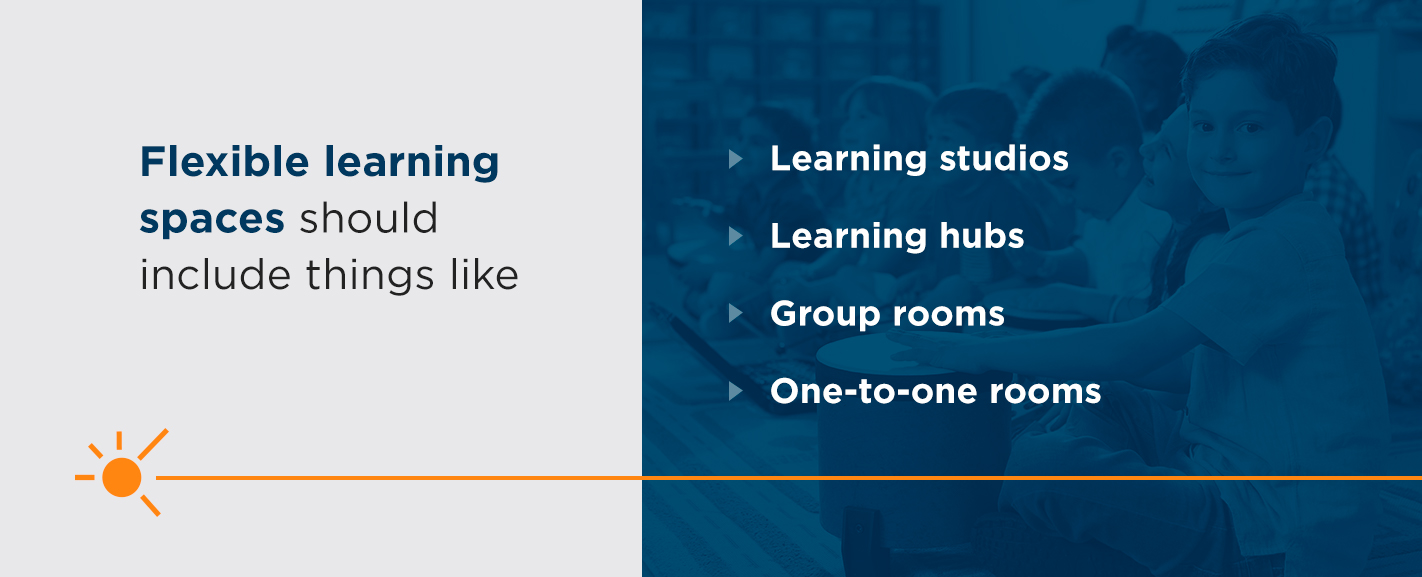
- Learning Studios — specifically for lectures or group instruction and looks like a classroom but with more flexible furniture options
- Learning Hubs — areas near the studios that have interactive learning stations used for team teaching
- Group Rooms — semi-private areas for small groups or team activities
- One-to-One Rooms — small, private rooms used for private instruction, testing or very small group activities
K-12 facility designs should also offer student choice, which could be in the form of small nooks where they can go to relax a bit and be in a quiet area or a big project lab they can go to work on something with other students. Creating connections — both physical and visual — between spaces can encourage a creative, collaborative environment where students can work toward their goals. For schools that seek extra involvement with the community and plan to open the school for community use, the design must ensure there is ample space for any activities they prepare.
As technology continues to make its way into K-12 schools across the U.S., designs must have flexible options that feature the way individual schools use technology in the classroom. Technology allows students to move outside of their traditional formal learning areas into different, more laid-back environments throughout the building. This shift could include things like adaptable furniture or incorporating more smart technology into the classroom.
K-12 Digital Technology Trends
Just like education, facility management trends for K-12 schools are rapidly evolving with new technological advancements. New technology makes it more challenging than before for schools to keep up with trends and provide leading industry solutions to the educational community. To keep up with digital facility management trends, schools can:
- Trade in the traditional classroom learning experience for a digital classroom environment
- Incorporate technology into the classroom
- Offer online classes
- Use technology to communicate with other classrooms
Digital Environments for Lessons
The days of sitting at a desk all day as teachers lecture at the front of the room are over. Implementing technology has changed lesson plans and the overall classroom environment. Today, classroom learning may be referred to as blended learning or tradigital learning, which encompasses a mix of both traditional classroom elements and the new digital learning environment. Unlike traditional teaching methods that rely on lecturing and may have incorporated digital tools only when necessary, tradigital teaching uses advanced digital tools to help facilitate lessons and further develop students’ learning skills.
Instead of remaining in one place for the majority of the day, tradigital learning encourages teachers in K-12 schools to incorporate stations that students can rotate around in the classroom. Teachers may start with two main stations — one that they lead and one where students use technology. A third station where students can collaborate with teachers and work on projects is usually then added. Teachers may add a fourth station that encourages more communication, collaboration, critical thinking and creativity. A fifth station serves as a place where students work independently. Implementing these stations in the classroom is the first main stage of tradigital leaning and a thriving digital classroom environment.
After teachers accomplish this, they can divide students into groups based on how they complete assessments before each unit. Teachers may opt to then go back to a three-station rotation that focuses on helping students based on the gathered assessment data but should reassess students before each new unit and arrange new groups accordingly. This method helps students get more personalized learning, which is the end goal of incorporating technology into the classroom. Teachers can separate lessons for each student through checklists and choice boards that give students more control of their education. A digital classroom environment includes numerous aspects of both teaching and learning. It is a powerful method for helping students develop their skills while keeping them up to date with technological trends.
Transition to Online Classes and the Digital Classroom
With the enormous digital shift in K-12 schools, things like textbooks could become relics of the past. In fact, 75 percent of teachers estimate that in the next 10 years, printed textbooks will be replaced entirely with digital learning content. More and more schools across the country are seeing the benefits of incorporating technology into the classroom. Benefits of a digital classroom include expanding courses, offering a new learning experience, supporting 24-7 learning, preparing students with necessary 21-century skills and increasing student participation and engagement. Teachers recognize these benefits, as 82 percent of U.S. teachers agree that incorporating technology helps prepare students for their future careers.
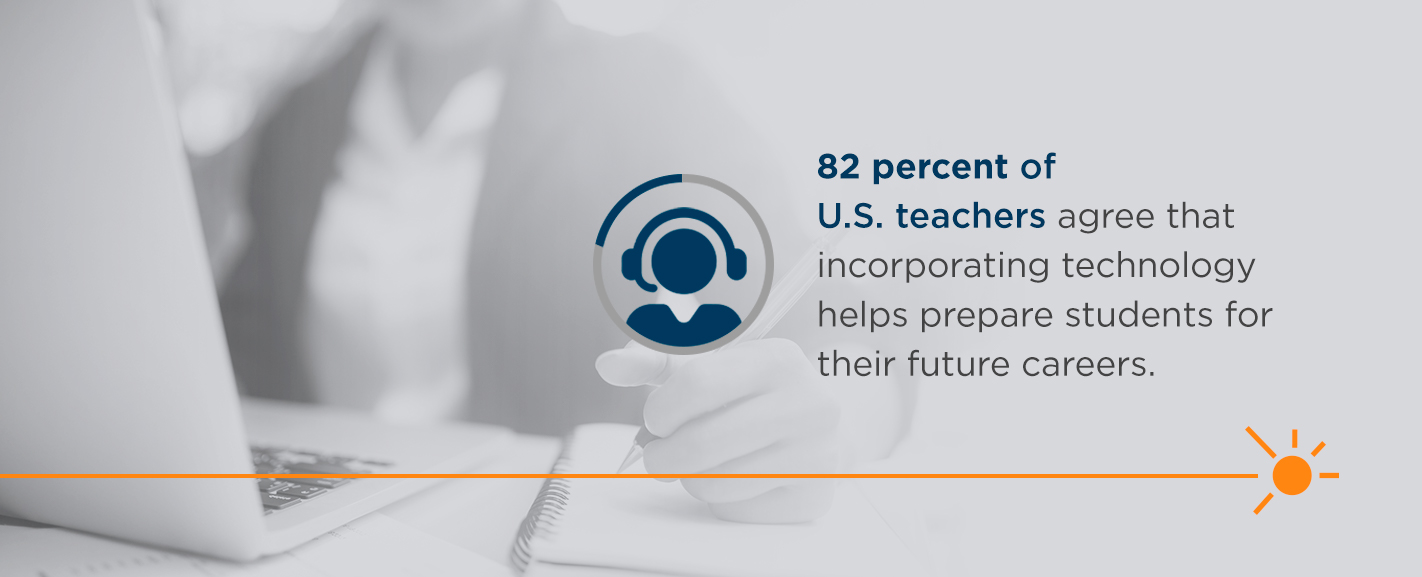
According to the Association for Supervision and Curriculum Development (ASCD), U.S. schools spend an estimated $56 billion annually on education technology, with K-12 schools making up about 36 percent of that amount. The cost of education technology could be considered minor compared to the rewards students can gain from a digital classroom. The University of Phoenix conducted a 2017 survey on teachers’ classroom habits and found that 63 percent of K-12 teachers were using technology in the classroom daily. The study also found that two in three K-12 teachers agree that incorporating technology in the classroom keeps students more engaged and creates a more interactive classroom setting.
Interacting With Other Classrooms Using Technology
Technology can also make it easier for students and teachers to interact with other classrooms. With video conferencing technologies, students and teachers can connect with other classes within a school, across the country and even across the planet. Collaboration tools like Google Docs allow students and teachers to share assignments in a similar way.
For some schools with classroom monitors and iPads, students may connect their iPads to monitors to collaborate with other classes or even host guest instructors and communicate with them. An increasing number of teachers are also taking to social media to work with other teachers and share ideas on how to keep things new and exciting in their classroom. As technology continues to accelerate, new methods of communication across different classes and even schools will emerge to make classroom learning an even more interactive experience for students and teachers alike.
K-12 Classroom Size Trends
Another popular facility management trend across K-12 schools in the U.S. is breaking down class sizes into smaller units. Keeping class sizes down moves away from the traditional classroom of 20-some students and makes for a more intimate learning experience for students. Plus, it can be challenging for teachers to manage large class sizes. Having smaller class sizes allows teachers to give students a more personalized learning experience, which will likely benefit their academic achievement. The Student/Teacher Achievement Ratio (STAR) study, one of the most influential studies on this topic, makes an excellent case for class size reduction.
The STAR study included 79 elementary schools and assigned students to kindergarten classes at random so that some were in classes of 22-26 students, while others were in smaller classes of 13-17 students. These kids stayed in the same size classes through third grade and were tested in reading and mathematics. Students in the smaller classes had higher test scores compared to students in the larger classes, especially for low-income and minority students. The benefits of small class sizes were reported to extend into the upper elementary grades, and students in small classes were even found to exhibit better behavior in the classroom. Some follow-up studies years after found that the students in small classes had better academic and personal outcomes for the rest of their schooling and beyond.
Schools have recognized the benefit of class reduction, and, today, 25 states have class size restrictions for at least some grades. Seven other states have established class size goals or incentives. Additionally, 77 percent of Americans report they would rather spend education money on reducing class sizes than paying teachers more. Trends may come and go, but many K-12 schools will likely keep pushing for smaller class sizes.
Here are some additional benefits of small class sizes:
- Easier to address any conflicts in the classroom
- Kids are more likely to pay more attention in smaller groups as fewer students may translate to fewer distractions
- Students may form closer relationships with classmates and teachers
- Could increase retention rates
- Can help teachers identify any learning disabilities early on
Sustainable K-12 Facility Management Trends
With more and more incentives to go green, many are making more environmentally-conscious decisions when it comes to just about everything — what they eat, how they travel and how they design buildings. You can shift toward more sustainable K-12 facility management by making simple changes, such as switching out your school’s fluorescent lighting for LED lighting.
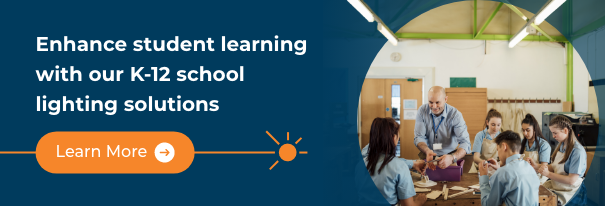
Benefits of LED Lights
Switching to LED lights at your K-12 school can prove to be very cost-effective and has many benefits, such as improved energy efficiency, flexibility and durability and better light quality overall. Schools have even seen improvements in academic performance after upgrading to LED lights. LED lights can imitate natural light, which has been shown to enhance one’s alertness, mood, energy and productivity. Therefore, LED lights can improve students’ concentration and overall performance. LED lights can also be adjusted to emphasize blue and white light — cooler light colors that are associated with increased productivity.
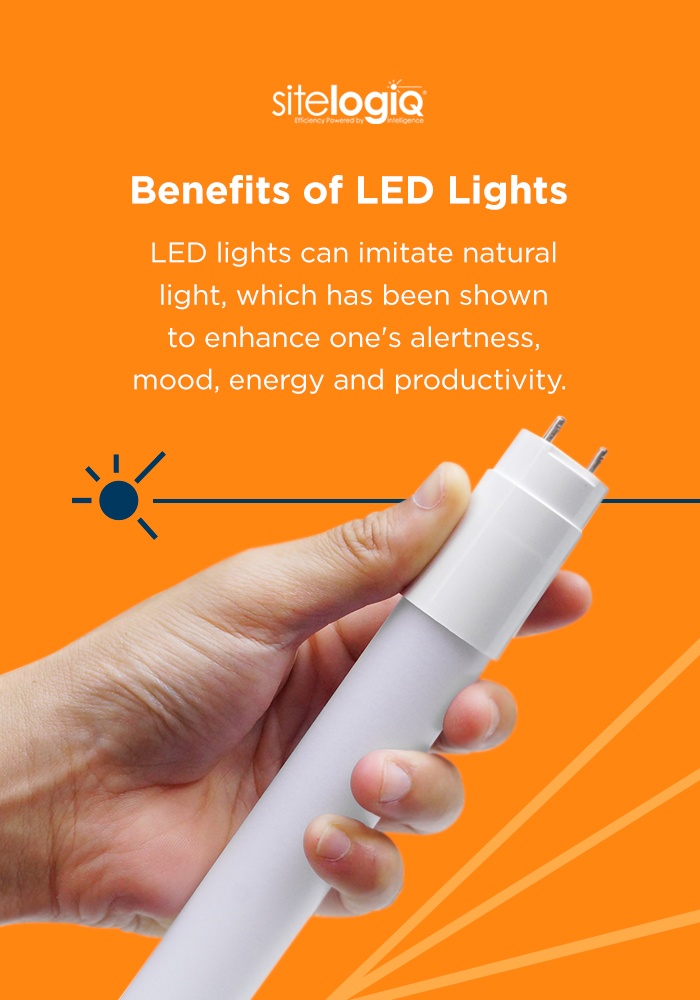
Your District can also save significant energy by switching to LED lights. Compared to incandescent lighting, LEDs last 25 times longer and use at least 75 percent less energy. Plus, LED light bulbs are more environmentally-friendly than other types of bulbs, as they are mercury-free and completely recyclable. Using LEDs also reduces the risk of exposure to harmful materials due to the lack of mercury and polychlorinated biphenyls (PCBs), which fluorescent lights may contain. Using LED lighting will also save your school money on its electric bill and can save you even more on maintenance costs since LED bulbs are easier to replace than fluorescent lights.
Upgrading your school’s lighting to LEDs also gives you more options when it comes to lighting controls. You can adjust the lights as needed throughout the day for students. This feature is especially helpful if you’re recording anything in the classroom for an online assignment, as you can get flicker-free LEDs that have dimming options to prevent any distracting flickering from appearing on your video. For any of your K-12 school’s lighting needs, hire a professional energy consultant to assist with energy management. The perks of energy management include things like detailed energy audits that look at all the specific elements that affect your school’s power usage and providing any retrofitting, repairs or maintenance on your school’s lighting or other areas.
LEED Certification
To take your school’s sustainability to the next level, LEED certification could be a consideration for your facility. LEED, Leadership in Energy and Environmental Design, was formed to enhance buildings’ overall energy efficiency and environmental performance. For your K-12 school to be LEED-certified, it must meet a series of prerequisites and then earn points to get to different levels of certification. Do you want your K-12 school to be certified but aren’t sure where to start? SitelogIQ has LEED-accredited professionals who can help your school find the most cost-effective solutions that work best for you and help you meet your sustainability goals. LEED consultants will guide you throughout the entire process from initiating the project in LEED online to submitting your credit interpretation requests to the U.S. Green Building Council (USGBC).
If you want to work toward more sustainable facility management but need some guidance, look into performance contracting for K-12 schools. With more than 700 professional engineers, project managers, certified energy professionals and team members to support your project, SitelogIQ can provide knowledgeable contracting for your District and help you find the best ways to make energy-efficient improvements to your facilities. Our experts can also discuss project financing options with your team.
Contact SitelogIQ Today to Enhance The Learning Environment of Your K-12 School
Improving the lighting of your K-12 school for a more sustainable facility can be challenging for one person to do alone. Our professional energy consultants can help you find the right environmentally conscious energy options for your school. Our team will give your project the attention it needs while providing resources and industry knowledge to answers any questions you have during the process. Most of all, SitelogIQ delivers results that can help you meet your goals. Don’t wait to start on your K-12 project — contact us today.


